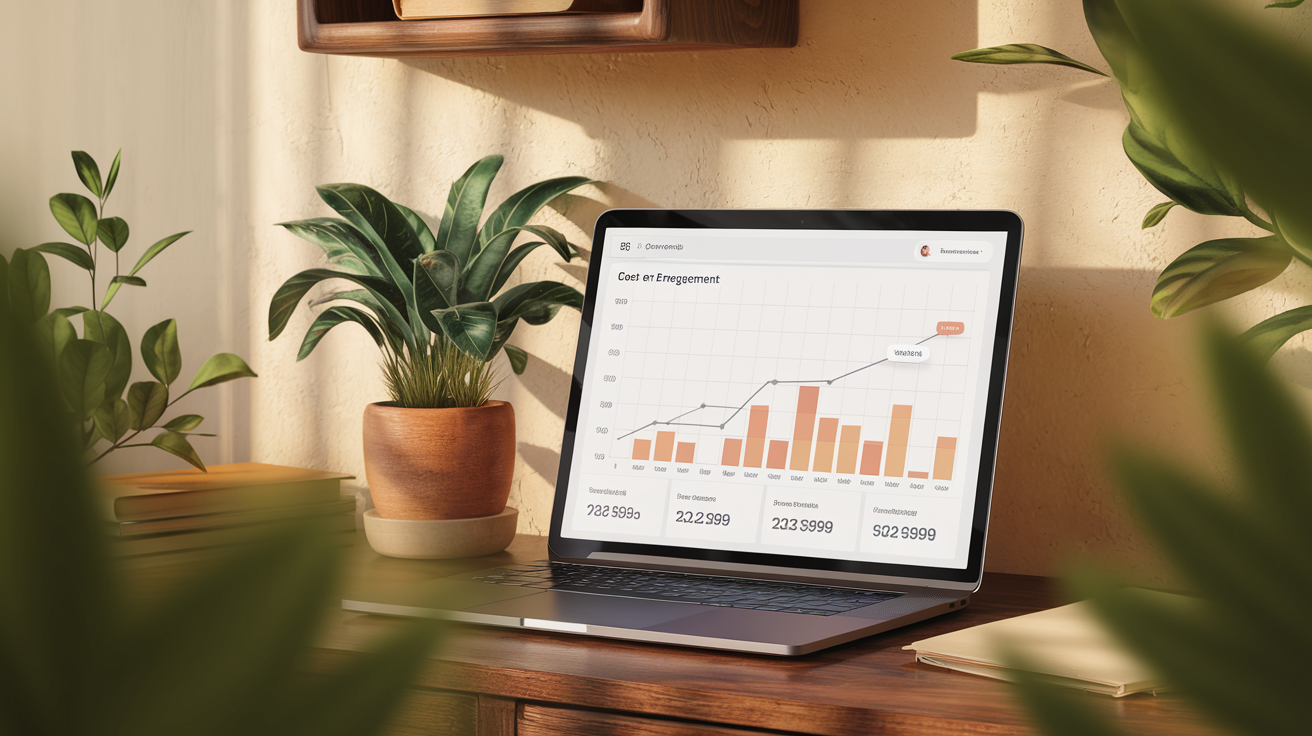Cost Per Engagement: Understanding and Optimizing Your Advertising Strategy
What is Cost Per Engagement (CPE)?
Definition of Cost Per Engagement (CPE)
Cost per engagement (CPE) represents an online advertising pricing model where advertisers pay only when users actively interact with an advertisement. Engagement actions include likes, comments, shares, or clicks. This model aims to ensure efficient use of advertising budgets by targeting users likely to engage with the content.
Calculation of CPE
CPE calculates using the formula:
CPE = Total Ad Spend / Total Number of Engagements
For instance, if an e-commerce brand invests $2,000 in a social media campaign that generates 5,000 likes and comments, the CPE would be:
CPE = $2,000 / 5,000 = $0.40
This calculation shows that the brand paid $0.40 for each engagement generated by their campaign.
Types of Engagement
CPE can break down into different engagement types, including:
- Platform-Specific CPE: Analyzing CPE across various platforms (e.g., Facebook, Instagram).
- Campaign-Specific CPE: Measuring CPE at the campaign level to determine which campaigns drive the most affordable engagement.
- Ad Format-Specific CPE: Analyzing CPE by ad format (e.g., video, carousel) to identify which formats yield the lowest CPE.
Factors Influencing CPE
Several factors influence CPE, such as:
- Ad Relevance: Ads resonating with the audience tend to achieve higher engagement rates and lower CPE.
- Audience Targeting: Precise targeting enhances engagement rates by reaching users likely to interact with the ad.
- Content Quality: High-quality, visually appealing content generally leads to increased engagement, reducing CPE.
How is Cost Per Engagement Calculated?
Definition of Cost per Engagement (CPE)
CPE measures the average cost incurred for each user interaction, such as likes, comments, shares, or clicks, in a digital advertising campaign. Marketers aim to increase audience engagement while controlling costs.
Calculation Formula
CPE calculates using the formula:
CPE = Total Ad Spend / Number of Engagements
This formula provides the average cost per user engagement, helping marketers assess campaign efficiency and engagement quality.
Example Scenario
For instance, if an e-commerce brand spends $2,000 on a social media campaign that generates 5,000 likes and comments, the calculation is:
CPE = $2,000 / 5,000 = $0.40
This indicates that the brand spent $0.40 for each engagement.
Influencing Factors
Several factors influence CPE:
- Ad Relevance: Relevant ads often lead to higher engagement rates and lower CPE.
- Audience Targeting: Precise targeting improves engagement rates as ads reach users likely to interact.
- Ad Format: Certain ad formats, like videos or carousels, may drive higher engagement.
- Platform Competition: High competition can increase CPE due to higher bidding costs.
Strategies to Reduce CPE
- Improve Ad Quality: Use high-quality visuals and compelling copy.
- Refine Audience Targeting: Focus on audiences most likely to engage.
- Leverage High-Engagement Formats: Test formats like video and carousel ads.
- Conduct A/B Testing: Identify the most engaging and cost-effective ad variations.
Tools for Measuring CPE
- Social Media Platforms: Tools like Facebook Ads Manager provide CPE metrics.
- Analytics Platforms: Google Analytics helps track engagement across campaigns.
- Enrich Labs' AI Social Media Coordinator: This tool autonomously moderates and analyzes social media interactions, providing insights that help optimize CPE while maintaining brand voice and consistency.
What are the Benefits of Using Cost Per Engagement?
Overview of Cost Per Engagement (CPE)
CPE is a pricing model in digital advertising where advertisers pay for specific actions taken by users, such as likes, shares, or comments, rather than just impressions or clicks. This model focuses on interactions indicating a deeper level of audience engagement with the content.
Benefits of CPE
Enhanced Engagement Measurement
CPE allows brands to measure campaign effectiveness based on actual user interactions. Analyzing how many users engaged with content provides a clearer picture of the campaign's impact on audience behavior.Cost Efficiency
By paying only for engagements, brands ensure that marketing budgets are spent efficiently. For example, if a brand invests $1,000 in a CPE campaign and gains 1,000 engagements, the cost per engagement would be $1. This contrasts with models where costs incur regardless of engagement, potentially leading to wasted spending.Focus on Quality Interactions
CPE incentivizes advertisers to create high-quality, engaging content. Since payment is based on actual engagement, brands invest in creative and compelling content that resonates with their audience. For instance, Spotify’s “Wrapped” campaign effectively used engagement-driven strategies on social media, resulting in significant shares and interactions, ultimately increasing brand loyalty and visibility.Targeted Marketing
CPE campaigns often utilize advanced targeting techniques to reach specific demographics, leading to more relevant audience interactions. TikTok’s Smart Performance Campaign automates ad delivery, optimizing for engagements based on user behavior and preferences.Real-Time Feedback and Insights
This model provides instant feedback on campaign performance. Advertisers adjust strategies based on engagement metrics, making real-time optimizations to improve results. Data from Buffer indicated that AI-assisted posts had a higher median engagement rate, prompting brands to refine their content strategies accordingly.Improved ROI
By focusing on engagements, brands achieve better return on investment (ROI). Advertisers track which types of content drive the most engagement and allocate resources accordingly, maximizing advertising spend.Increased Visibility on Social Platforms
Higher engagement rates lead to better visibility on social media platforms due to algorithms favoring content generating interactions. Facebook’s algorithm promotes posts with higher engagement, enhancing organic reach.
Case Studies and Examples
- Spotify’s Wrapped Campaign: Leveraging user data for personalized content led to over 280 million views on Facebook alone, showcasing the power of engagement-focused strategies.
- Buffer's AI Assistant: Analysis revealed that AI-assisted posts had a median engagement rate of 5.87% compared to 4.82% for non-AI posts, highlighting how engagement-centric content creation leads to better results.
How Does Cost Per Engagement Differ from Cost Per Click?
Definitions
Cost Per Click (CPC)
CPC is a pricing model in online advertising where advertisers pay each time a user clicks on their ad. This metric commonly appears in search engine advertising and social media platforms like Google Ads and Facebook Ads. For instance, in Q3 2024, retail media search ads had an average CPC of $1.32, while Google search ads had a CPC of $1.16, indicating varying costs based on the platform and user intent.
Cost Per Engagement (CPE)
CPE measures the cost of a user interacting with an ad more meaningfully than just clicking. Engagement includes actions such as likes, shares, comments, or other interactions indicating deeper interest. CPE metrics are generally higher than CPC because they encompass a broader range of user interactions.
Key Differences
- Pricing Structure: CPC is strictly based on clicks, while CPE includes various engagement types, potentially leading to higher costs per engagement since engagement actions typically require more effort and interest from the user.
- User Intent: CPC reflects immediate interest (a click), while CPE indicates a deeper level of interaction, suggesting that the user finds the content more engaging and relevant.
- Measurement Focus: Advertisers may prefer CPC for campaigns focused on driving traffic to websites. CPE is often sought for brand awareness and engagement campaigns where interaction metrics are more valuable.
Case Study Example
For instance, a brand running a campaign on both Facebook and TikTok might find that its CPC on Facebook is relatively low, but the CPE is significantly higher on TikTok due to the platform's nature encouraging more interactive content. Brands may choose to invest more in platforms providing higher engagement, even if the CPC appears lower on other platforms. This strategy aligns with findings that TikTok ads deliver significantly more impressions, albeit at a higher CPC, but may ultimately yield better engagement rates.
What Types of Engagement Are Measured in CPE?
Types of Engagement in Cost Per Engagement (CPE)
CPE serves as a crucial metric in digital marketing measuring the average cost incurred for each user interaction with content. The types of engagement typically measured in CPE include:
- Likes: The number of times users express approval of a post or content.
- Comments: User-generated responses or feedback on posts, indicating deeper engagement.
- Shares: When users redistribute content to their networks, amplifying its reach and visibility.
- Clicks: The number of times users click on links within posts, leading to external sites or additional content.
- Saves: Particularly relevant on platforms like Instagram, where users save posts for later reference, indicating value.
Examples and Case Studies
E-commerce Campaign: An e-commerce brand spent $2,000 on a social media campaign, generating 5,000 likes and comments. This resulted in a CPE of $0.40, calculated as $2,000 / 5,000 engagements. This measurement helps the brand understand the cost-effectiveness of its influencer partnerships and guides future marketing strategies.
Influencer Marketing Analysis: In a comprehensive analysis of influencer marketing campaigns, brands gather data on likes, comments, shares, and saves to calculate CPE. For example, if a campaign involving multiple influencers results in a total of 10,000 engagements from a $4,000 spend, the CPE would be $0.40. This analysis allows brands to compare the performance of different influencers and optimize their future marketing budgets.
Ad Format-Specific CPE: A tech company tracked its CPE across different ad formats and found that video ads yielded a CPE of $0.60, while static image ads had a CPE of $0.80. This insight prompted a strategic shift towards more video content to enhance engagement rates.
Summary
CPE serves as a vital metric for evaluating the cost-effectiveness of digital marketing campaigns. Engagement types, including likes, comments, shares, clicks, and saves play a significant role in its calculation. For those seeking to enhance their social media engagement and streamline interactions, consider exploring Enrich Labs' AI Social Media Coordinator—a solution designed to automate and optimize your social media strategy, allowing your team to focus on high-impact tasks. Learn more about Enrich Labs here.




